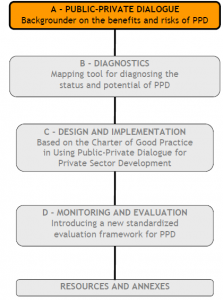The handbook identifies factors to consider at each stage of a continuous, cyclical process of building and improving dialogue. Taken as a whole, it builds up into a practical toolkit to:
- diagnose the capacity of the public and private sectors to engage in dialogue and the areas in which dialogue can be most fruitful;
- design a dialogue process that gives the best chance for productive interactions between public and private sectors to emerge;
- implement dialogue with an awareness of risk factors that can develop and the ability to identify and address problems as they arise;
- evaluate the effectiveness of dialogue mechanisms, feeding back into the diagnosis phase for designing and implementing improvements.
The first part of this handbook thus consists of a mapping tool for diagnosing the status and potential of public-private dialogue. It proposes a standardized tool for assessing the willingness and capability of stakeholders to engage in dialogue aimed at promoting investment climate reforms and private sector development.
The second part of this handbook gives indications for practitioners designing or implementing partnerships. It is based around the Charter of Good Practice in using Public Private Dialogue for Private Sector Development (the “PPD Charter”). The PPD Charter was drafted by participants at the first International Workshop on Public Private Dialogue in 2006 and subsequently revised through an iterative process of feedback via the www.publicprivatedialogue.org website.
The principles of the Charter summarize 12 essential elements to consider when designing and implementing a public-private dialogue project:
- Assessing the optimal mandate and relationship with existing institutions
- Deciding who should participate and under what structure
- Identifying the right champions and helping them to push for reform
- Engaging the right facilitator
- Choosing and reaching target outputs
- Devising a communications and outreachstrategy
- Elaborating a monitoring and evaluation framework
- Considering the potential for dialogue on a sub-national level
- Making sector-specific dialogue work
- Identifying opportunities for dialogue to play an international role
- Recognizing the specificities and potential of dialogue in post-conflict or crisis environments
- Finding the best role for development partners (aka donors)
The handbook takes each of the 12 principles in turn and elaborates on them with practical advice and suggestions, including examples of international good practice.
The third part of this handbook elaborates on the techniques to evaluate the impacts of a public-private dialogue mechanism. While monitoring tools can be used by partnerships to review their internal progress, it is crucial for the community of practitioners to have access to a standardized and objective
methodology that enables objective and standardized measurement of impacts.
To that effect, this chapter presents a new methodology especially adapted to public-private dialogue. It describes the project management steps that evaluators need to undertake, the type of data collection methods, and presents a three-part evaluation framework.
This impact-assessment tool will enable external evaluators to measure the effectiveness of a PPD across three areas: organizational process, impacts on the reform process, and economic impacts. The authors recommend all PPD practitioners adopt this new methodology, as this will allow for benchmarking between different initiatives of different natures in different countries
The Annexes contain sample templates relevant to PPD efforts, which practitioners can take and adapt to local contexts and circumstances.

